LED Grow Light Basics
| Lesson 1 | The Quick Guide to LED Grow Lights |
| Lesson 2 | All the light science you need to know to grow a plant |
| Lesson 3 | Is an LED light ideal for your situation? (The truth is LED’s aren’t always the best fit) |
| Lesson 4 | Qualities of Good LED Grow Lights |
| Lesson 5 | Read My Recommendations and Reviews |
![]()
All the Light Science You Need to Know to Grow a Plant
According to your fifth grade science class a plant needs three things to grow: (1) Energy from Sunlight, (2) Carbon Dioxide from Air, and (3) Water from Soil. This site, for obvious reasons, will focus on requirement #1, lighting.
Quick Review of Photosynthesis (and I mean quick)
Let’s talk about photosynthesis. If you can stretch your mind back to fifth grade, then you’ll remember that plants are amazing because they can produce food for themselves. They take carbon dioxide and water (not foods) and use the energy from sunlight to turn these “not foods” into sugar (foods).

If a plant can’t go through the process of photosynthesis, then it will die. What does this mean for you? It means that you need light to turn the “not foods” into “foods”. Simple, right?
All the Light Science You Need to Know about LED Lights
You need light to grow your plants. Well, you have several choices (all are good):
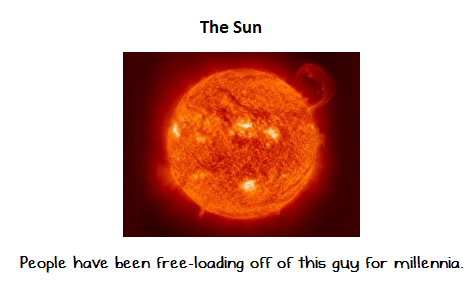
- The Sun (a very popular, free light that many plant growers use)
- High-Intensity Discharge Lights (HIDS). Not as popular as the sun, but still popular.
- Metallic-Halide Lights (MHs) — Great Lights!
- High Pressure Sodium Lights (HPSs) — Great Lights!
- Fluorescent Lights — Great Lights!
- Light-Emitting Diodes (LEDs) — My personal favorite (yes, I’m biased 😉 )
Normally people use the sun to grow plants because of the price-savings. Scientists and your average gardeners have found that other lights like LED lights can be used to grow plants as well. Many people have had success growing plants using LED grow lights.
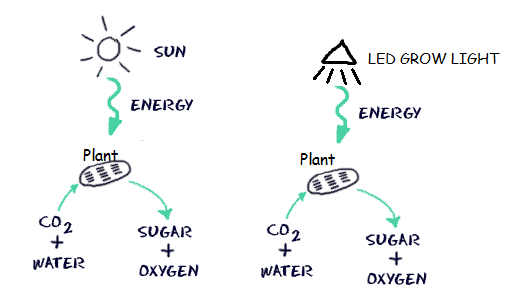 The sun’s light contains a variety of different colors. Plants, for the most part, absorb the red and blue light put off by the sun and reflect the other light (as illustrated below). Plants reflect green light and that is why they appear green to us. The sun and other growing lights shoot out light colors that aren’t needed by the plant. LED lights can be fine-tuned to only produce the light plants need.
The sun’s light contains a variety of different colors. Plants, for the most part, absorb the red and blue light put off by the sun and reflect the other light (as illustrated below). Plants reflect green light and that is why they appear green to us. The sun and other growing lights shoot out light colors that aren’t needed by the plant. LED lights can be fine-tuned to only produce the light plants need.
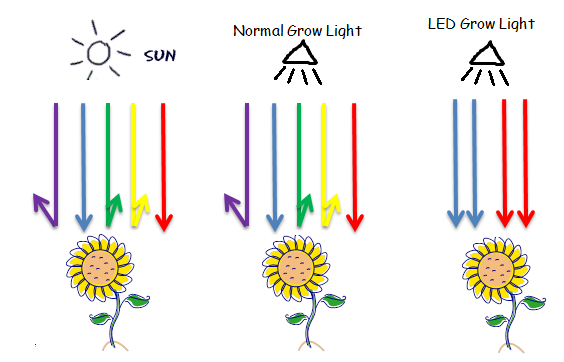
Because of this control over the light output by LED lights, they are said to be “more efficient” than traditional lights. This means they provide the plant what it needs without as much waste. There is more science behind this, but all you really need to know is that LED grow lights consume less energy and last longer than traditional grow lights.
Blue and Red Light Basics
The blue light helps the plant grow big, green, and tall (the vegetative stage) and the red light helps the plant flower and produce vegetables, or whatever it is the plant is producing. Most LED grow lights come with both blue and red light now so they can grow your plant from start to finish.
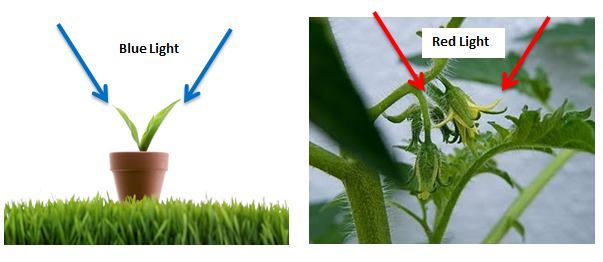
Hours of Sunlight
So you understand the basics, but you probably want to know how many hours each day should the light be pointing at your plants? The truth is it depends on what you’re growing. I’ll provide you with some general advice though. I recommend 18 hours of light and 6 hours of darkness during the germination stage (when the plants are just seeds). After the seeds sprout out of the ground, move it to 16 hours of light and 8 hours of darkness. Once the plants grow and start flowering, it’s not a bad idea to switch them to a 12 hours on, 12 hours off schedule.
This pattern mimics the sun (that big free light in the sky). The closer to winter it gets, the less the sun shines. The decreased amount of light acts as warning sign for plants to “get a move on it” and start flowering and yielding their fruits or vegetables.
Conclusion
Now you know all the light science you need to know to grow a plant. Do yourself a favor and stop researching more about this. I know that sounds pushy, but I’ve seen too many people get bogged down at this point in their plant growing journey. People spend hours and hours researching when what they really need to do is learn the basics, move on, and start growing and experimenting. Move on to step 2 by reading my next article about determining which type of grow light is best for your situation, choose the type that you think most closely fits your situation, purchase the thing, and for heaven’s sake start growing (this is where you will find the true happiness that comes from gardening).
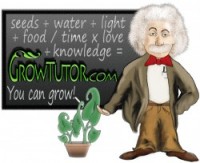

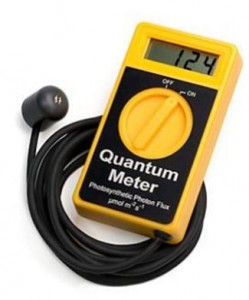
I’m wondering if the fact that you’re only getting red and blue sides of the spectrum and nothing in-between has any effects on the finished product as far as potency, yield or effect?
Hey Brock,
Great question/point. The truth is my illustration is a bit simplistic (I did it this way on purpose to illustrate a point). Most LED grow lights actually come with several different colors/wave-lengths in them. The idea is that you can identify exactly what the plant needs in terms of light and then match it, very efficient.
Thanks for stopping by and contributing.
Nate
Right on. Thanks for the response
I am using led lights for growing. The led lights I am using are 660 nm red 80% and 440 nm blue at 20 % I am thinking of adding an orange color at 600 nm what were your thoughts?
Hey Dan,
Good question. I know that many of the main players in the industry have been placing some orange in their lights (Prosource for one). That being said, some of the very latest LED grow lights are now targeting the 525nm and the 640nm range instead. They are saying that the orange isn’t as helpful as they thought and they are finding that green might be more helpful than they thought for growth deeper within the plant.
I probably opened up more questions than I answered for you (sorry about that). The truth is the “perfect” spectrum hasn’t been found (in fact, there may not be a perfect spectrum, it probably varies depending on the type of plant you’re growing). How has your light been performing?
Best,
Nate
Hey!
You wrote:”The idea is that you can identify exactly what the plant needs in terms of light ”
Sorry, How to identify it?
Hey Alex,
That must have been lost in translation. The idea is that scientists have discovered the exact wavelengths of light that plants need. You don’t have to blast out all the different wavelengths because plants don’t need them all. HID lights can’t be manipulated to only project certain wavelengths, but LED lights can (that makes them more efficient). Here’s a more detailed write-up about the subject: http://growtutor.com/why-leds-are-more-efficient-than-hids/. Basically HID lights are just blasting light everywhere (they aren’t efficient). LED can be controlled and are much more efficient.
Let me know if you have any more questions.
Best,
Nate
And would be nice to see also meters & santimeters and 1 to 5 point system in your reviews.
I’m from Russia )))
You’d prefer a 5 star system instead of the grades eh? I might have to do that.
I’ll try adding meter and centimeters in the future reviews.
I appreciate the suggestions.
Nate
I am starting vegetable seeds (eggplant, lettuce, tomatoes, etc) indoors before moving them outside after the first frost. Have I heard incorrectly that with LED lighting, there may be a danger of shocking the plants with the change?
… of course, I’ll be moving the plants outside after the danger of frost, not after the first frost.
And although I know that LEDs are higher efficiency, is a 13W panel strong enough to do the job?
Hey Alex,
Would you mind sending a link to the 13 watt light you’re talking about?
I’m not sure how many plants you are starting but a 13 watt light should be okay for starting your plants, but I wouldn’t rely on a light with that low of power for too long. Once the plants get a little bigger it might not be enough light.
One thing I would do in your situation is supplement your seeds with some sunlight by putting them close to a window. This serves two purposes: (1) Your plants will get some of the additional light they need (let’s face it 13 watts just isn’t a lot). and (2) This will help them acclimate for when you place them outside.
Now, there is always a danger of shocking the plants when you change them from indoors to outdoors (no matter what type of light you are using). That’s why you are going to want to take your plants through what is called the hardening off process. You should really google or read more about it (here’s a pretty good article that explains the process http://gardening.about.com/od/gettingstarted/qt/Hardening_Off.htm). Basically you have to transition them outdoors over a period of time. Any indoor plant moved outside can face a shock.
In other words, this is not an issue with LED lights, but an issue of moving from a nice controlled environment out to mother nature!
Good luck and keep us updated.
Nate
Whats a good wattage to use to bud with red leds?
Hey Adam,
Are you only using red LEDs? I haven’t ever used a light that only had red LEDs. I don’t think I’d recommend that, except for supplemental lighting.
Best,
Nate